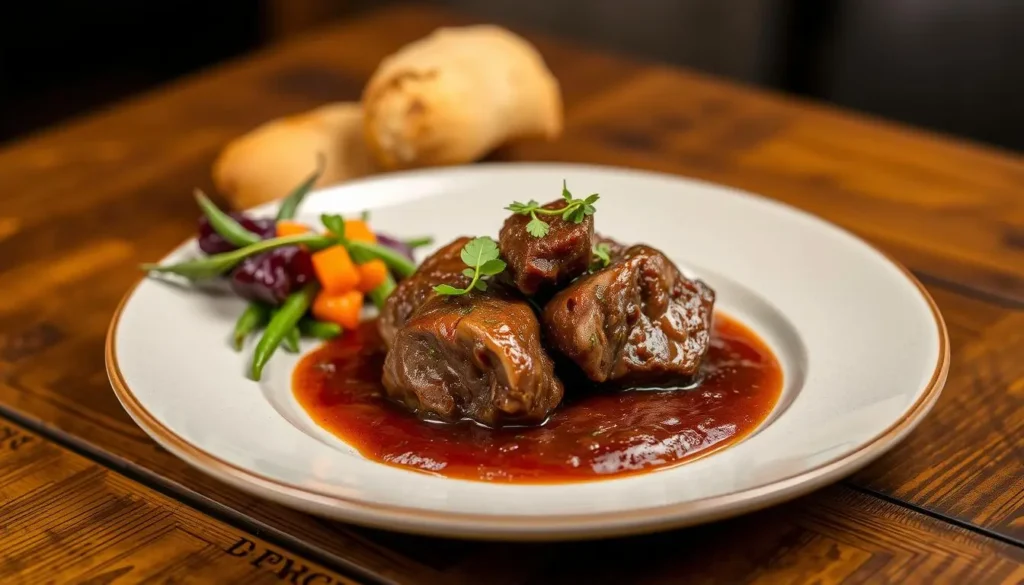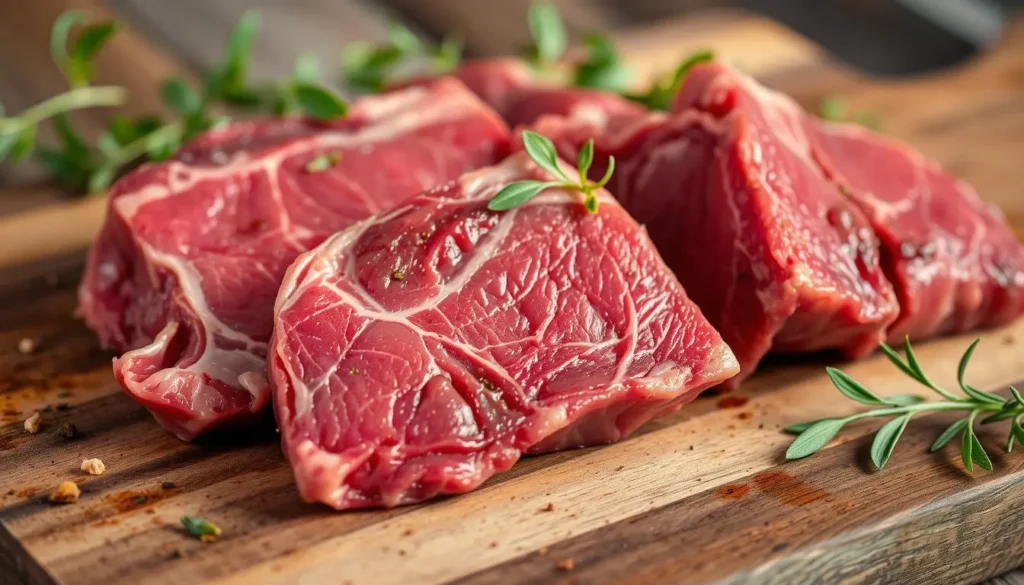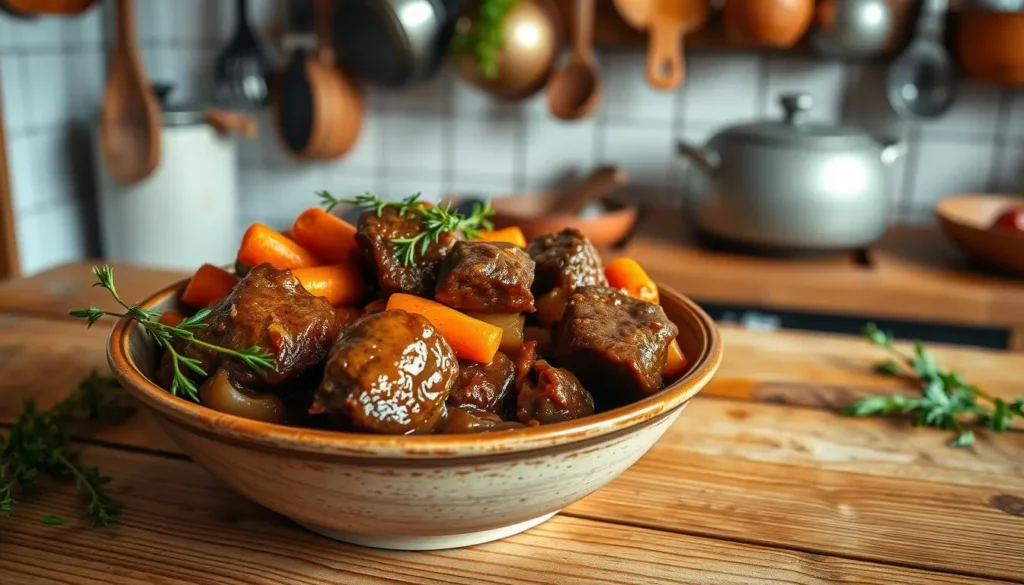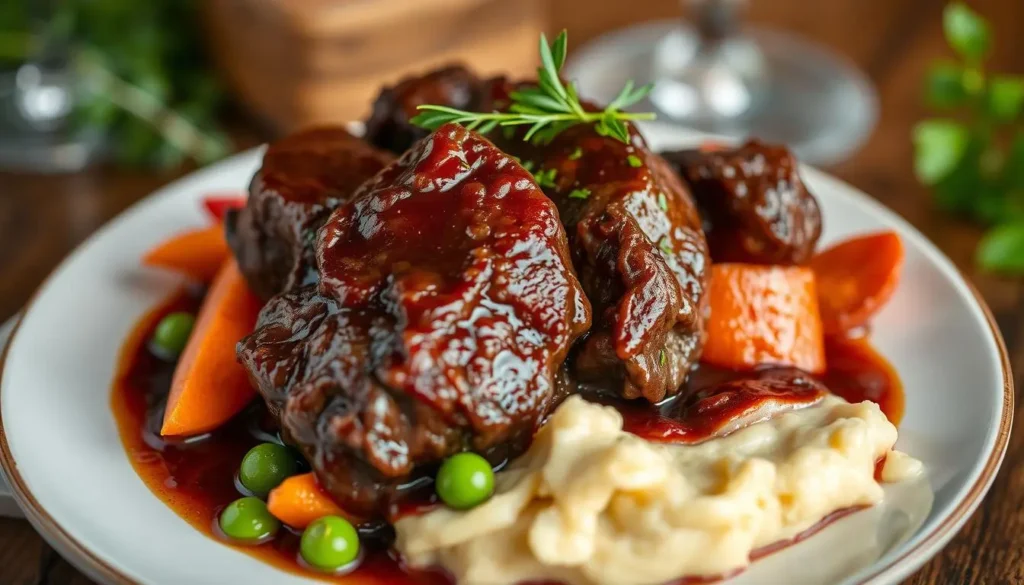Seventy-five percent of chefs in the United States love beef cheeks. They find the rich, tender flavor irresistible. This cut is special, with a unique texture and taste that stands out.
Beef cheeks are gaining popularity fast. Chefs and food lovers can’t get enough of their rich, beefy flavor. They’re a favorite in fancy restaurants and a great choice for home cooks looking to try something new.
Key Takeaways
- You’ll discover the unique texture and flavor profile of beef cheeks, making them a standout cut of beef.
- Braised beef cheeks are a delicacy, with 75% of chefs in the US considering them a favorite ingredient.
- Beef-cheeks are perfect for slow-cooking, resulting in a tender, fall-apart texture.
- This cut of beef is rich in flavor, with a deep, beefy taste that’s sure to impress.
- Whether you’re a seasoned chef or a curious home cook, beef cheeks are an exciting and delicious option to explore.
- As you explore the world of beef cheeks, you’ll learn about the growing popularity of this cut and why it’s becoming a favorite among food enthusiasts.
- Braised beef-cheeks are a staple of many high-end restaurants, and can easily be made at home with the right techniques and ingredients.

What Are Beef Cheeks and Why They’re Special
Ever wondered what are beef-cheeks called in USA? Beef-cheeks, also known as beef cheek meat, come from a cow’s facial muscles. They are tender and have a deep flavor, perfect for slow-cooked dishes.
In the United States, they are called beef cheek meat or cheek cuts. Harvested from the cow’s head, their unique location gives them a special texture and taste.
Anatomy and Location
The masseter muscles, which control the cow’s jaw, make beef-cheeks work hard. This hard work leads to a tender and juicy texture when cooked. Knowing where beef-cheeks come from helps us see their value in cooking.
Unique Texture and Flavor Profile
Beef-cheeks have a soft, melt-in-your-mouth texture. They’re great in braises, stews, or soups, soaking up all the flavors. If you want to impress with your cooking, try beef-cheeks.
Nutritional Benefits
Beef-cheeks are not just tasty but also nutritious. They’re full of protein, vitamins, and minerals, making them good for a healthy diet. Their rich flavor and health benefits are why they’re gaining popularity in the United States.
Finding Beef Cheeks in American Markets
In American markets, beef-cheeks might have different names. You can find them in specialty butcher shops, ethnic markets, and online. For top-quality beef cheeks, visit a local butcher or a high-end grocery store.
In the USA, they are also known as beef cheek meat or cheek beef. If they’re not in your local market, ask the butcher if they can get them for you. Online, you can check Amazon and butcher shops that ship nationwide.
Here are some tips for finding beef cheeks in American markets:
- Check with local butcher shops or specialty meat markets
- Look for online sources that ship nationwide
- Ask your local grocery store if they carry beef cheeks or can order them for you
Some well-known brands for beef-cheeks are Snake River Farms and American Wagyu. Searching for what are beef cheeks called in USA can also help you find where to buy them.
By following these tips, you should be able to find high-quality beef-cheeks in American markets. Beef-cheeks are great for trying new recipes or experimenting with different meats.
Understanding the Cost of Beef Cheeks
Beef-cheeks can be pricey, making you wonder, why is beef cheek so expensive? Several factors contribute to this, like their popularity, where they’re found, and the quality of the beef. Sometimes, beef-cheeks are cheaper than cuts like ribeye or filet mignon.
In the U.S., beef-cheeks’ price changes by region. The Northeast often has higher prices because of shipping costs and local demand. But, the Midwest, with its big cattle ranches, might have better deals. Here are key factors that influence beef-cheeks’ cost:
- Regional availability and demand
- Quality and grade of the beef
- Cut and trim level
- Local competition and market trends
Beef-cheeks might seem pricey at first, but they’re affordable in large batches. A single cheek can feed 2-3 people, which is great for families or groups. So, beef-cheeks can be a cost-effective choice for a unique, tasty dish.
| Cut of Beef | Average Price per Pound |
|---|---|
| Beef Cheeks | $6-$8 |
| Ground Beef | $4-$6 |
| Ribeye | $10-$12 |
Selecting Quality Beef Cheeks
Choosing the right beef-cheeks is key for a great dish. So, are beef cheeks good meat? Yes, they are perfect for slow-cooked recipes. Look for a deep red color and firm texture. Also, check for marbling, which adds flavor and tenderness.
A quality beef cheek has moderate marbling. This keeps the meat moist. Check freshness by smell and texture. Avoid strong odors or soft textures, as they’re likely old.

- Choose beef-cheeks with a good balance of fat and lean meat
- Opt for beef-cheeks from grass-fed cattle for a more robust flavor
- Avoid beef-cheeks with a lot of connective tissue, as this can make them tough
By following these tips, you’ll get the best beef-cheeks for your recipe. And to answer the question,are beef-cheeks good meat? Absolutely, when chosen and cooked right, they’re delicious and tender.
Essential Preparation Steps
Working with beef-cheeks requires proper preparation for the best taste and texture. Start by trimming and cleaning the cheeks, removing fat and connective tissue. This step is key for a tender and flavorful dish.
Next, think about marinating your beef-cheeks to boost their flavor. You can pick from dry rubs or wet marinades. Olive oil, garlic, and herbs like thyme and rosemary are great choices.
Trimming and Cleaning
To trim and clean your beef-cheeks, use a sharp knife and a cutting board. Remove visible fat and connective tissue. Then, rinse the cheeks under cold water to get rid of impurities.
Marinating Options
For marinating, you can go for a dry rub or a wet marinade. Dry rubs mix spices and herbs, while wet marinades use liquids like olive oil or vinegar. Here are some popular options for beef cheeks:
- Dry rub with garlic and herbs
- Wet marinade with olive oil and lemon juice
- Asian-style marinade with soy sauce and ginger
Equipment Needed
To cook beef-cheeks, you’ll need some basic tools. You’ll need a sharp knife, a cutting board, and a Dutch oven or heavy pot.
| Equipment | Description |
|---|---|
| Sharp knife | For trimming and cleaning the beef-cheeks |
| Cutting board | For preparing the beef-cheeks |
| Dutch oven or heavy pot | For braising the beef-cheeks |
Classic Braised Beef Cheeks Recipe
To make tender and flavorful beef-cheeks, follow a few steps. Start by seasoning the cheeks with salt, pepper, and herbs. Then, sear them in a hot pan to keep the flavors locked in.
Next, add onions, carrots, and celery to the pan. Pour in red wine or stock to cover the beef. Cooking the beef low and slow breaks down the connective tissues, making it tender. Move the pan to the oven and cook at a low temperature for hours.

- Mushrooms and red wine
- Tomatoes and herbs
- Onions and garlic
By following this classic recipe and trying different flavors, you’ll make a dish that’s both delicious and memorable. It will showcase the unique qualities of braised beef-cheeks.
Alternative Cooking Methods
There are many ways to cook beef cheeks, not just braising. You can make them tender and tasty with different methods. For example, slow cookers are great for cooking beef cheeks while you’re doing other things.
Cooking beef cheeks in a slow cooker makes them tender and flavorful. Brown the cheeks in a pan first. Then, put them in the slow cooker with your favorite liquid and spices. Let it cook for 8-10 hours for a delicious dish.
Slow Cooker Technique
- Brown beef cheeks in a pan before transferring them to the slow cooker
- Choose a suitable liquid, such as stock or wine, to cook the beef cheeks in
- Cook on low for 8-10 hours or high for 4-6 hours
Pressure cookers are another option. They cook beef cheeks fast without losing flavor. You can also try sous vide for perfect results every time.
Pressure Cooker Method
Beef cheeks cook quickly in a pressure cooker, in under an hour. Brown the cheeks, add liquid and spices, and cook for 30-40 minutes.
Sous Vide Approach
The sous vide method seals the beef cheeks in a bag and cooks them in water. This method ensures even cooking and keeps the meat tender.
| Cooking Method | Cooking Time | Result |
|---|---|---|
| Slow Cooker | 8-10 hours | Tender, fall-apart beef cheeks |
| Pressure Cooker | 30-40 minutes | Quickly cooked, flavorful beef cheeks |
| Sous Vide | 1-2 hours | Evenly cooked, tender beef cheeks |
Perfect Side Dishes and Wine Pairings
When you serve braised beef cheeks, you need to match their rich flavor with the right sides. Creamy polenta, roasted root vegetables, or a simple salad with light vinaigrette are great choices. These options balance the bold taste of the braised beef cheeks.
For wine pairings, you have many choices. A red wine like Cabernet Sauvignon or Syrah goes well with the braised beef cheeks. A white wine like Chardonnay or Pinot Grigio offers a nice contrast. Here are some more wine options:
- Merlot: a smooth and approachable red wine that pairs well with the rich flavor of braised beef cheeks
- Pinot Noir: a light-bodied red wine with flavors of cherry and earth that complement the bold flavor of the meat
- Sauvignon Blanc: a crisp and refreshing white wine that can help cut through the richness of the dish
Remember, the key to pairing wine with braised beef cheeks is finding a balance. Look for a wine that complements the meat’s bold flavor. Try different wines to find the perfect match for your taste.

Storing and Reheating Tips
After cooking your beef cheeks, it’s key to store them right. This keeps them safe and tasty. You can keep them in the fridge for 3 days or freeze for 3 months. Always use a covered, airtight container and keep it at 40°F (4°C) or below.
Reheating beef cheeks safely and moist is important. Here’s how to do it right:
Proper Storage Methods
- Refrigerate cooked beef cheeks at 40°F (4°C) or below
- Freeze cooked beef cheeks at 0°F (-18°C) or below
- Use airtight, covered containers to prevent contamination and spoilage
Reheating Guidelines
To reheat your beef cheeks, use the oven, microwave, or stovetop. Here’s what to do:
- Oven: Reheat at 300°F (150°C) for 10-15 minutes
- Microwave: Reheat on high for 30-60 seconds, or until heated through
- Stovetop: Reheat over low heat, stirring occasionally, until heated through
By storing and reheating your beef cheeks correctly, you can enjoy them longer. They’ll stay tender and flavorful.
| Storage Method | Temperature | Shelf Life |
|---|---|---|
| Refrigeration | 40°F (4°C) | Up to 3 days |
| Freezing | 0°F (-18°C) | Up to 3 months |
Conclusion: Mastering the Art of Beef Cheek Preparation
As we wrap up our journey with beef cheeks, it’s clear they’re a true culinary treasure. Their unique flavor and tender texture make braised beef cheeks a treat to eat. By using the tips from this guide, you can bring out the best in this often-neglected cut. You’ll wow your loved ones with your cooking skills.
The secret to mastering beef cheeks is choosing the right cut, preparing it well, and cooking it patiently. You can slow-braise them or try other methods like slow cookers or pressure cookers. Either way, you’ll get a dish that’s both comforting and flavorful. So, go ahead and explore the world of beef cheek cooking. Your taste buds will love you for it!
FAQ
What are beef cheeks called in the USA?
In the USA, beef cheeks are also known as ox cheeks or beef cheek meat. The names can differ by area. So, it’s best to ask your butcher or check labels at specialty meat shops.
Are beef cheeks considered good meat?
Yes, beef cheeks are excellent meat. They have a rich, beefy flavor and become tender when cooked. Their high collagen content makes them juicy and full of flavor when slow-cooked.
Why are beef cheeks so expensive?
Beef cheeks are pricier than other cuts. They’re less common but in high demand. Chefs and home cooks adore their taste and texture.
Preparing them is also hard work. This adds to their cost.
Are beef cheeks a cheap cut of meat?
Beef cheeks are actually a budget-friendly choice. They’re cheaper than premium cuts like ribeye or filet mignon. Their flavor and tenderness when slow-cooked make them a great value for many cooks.

